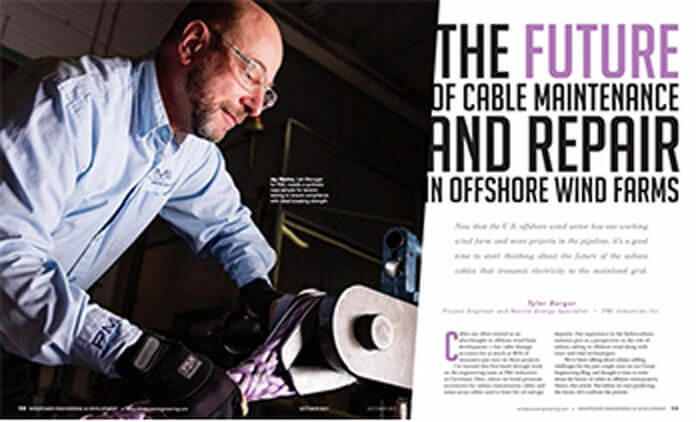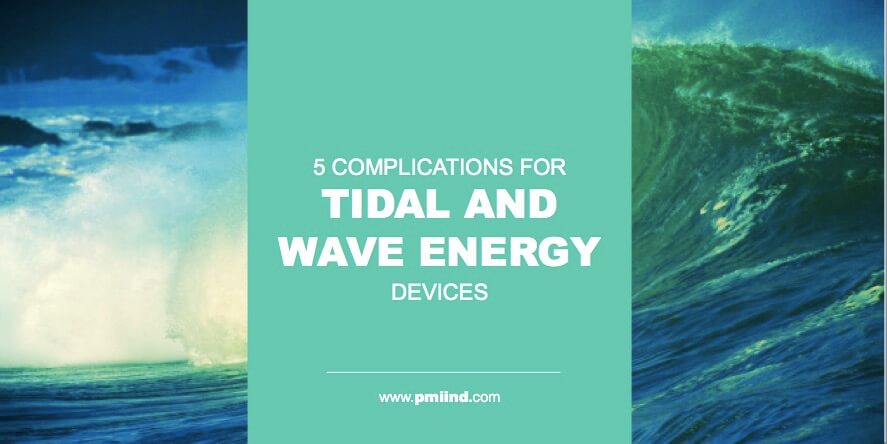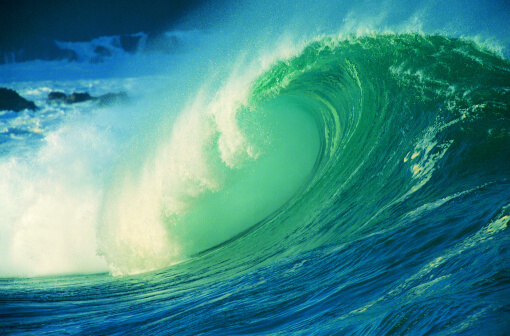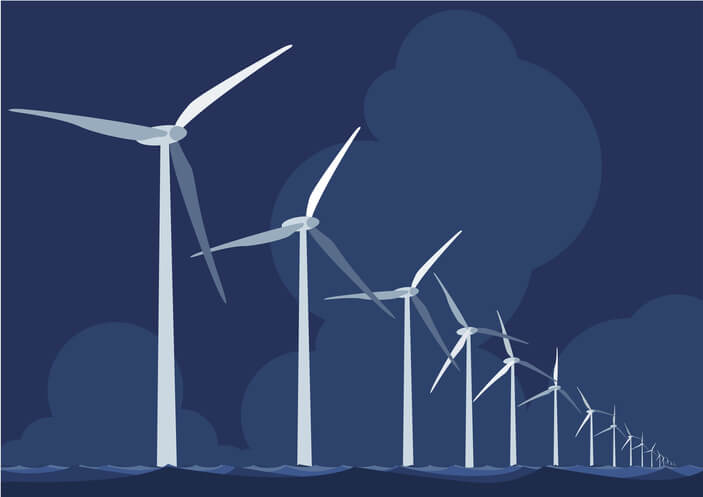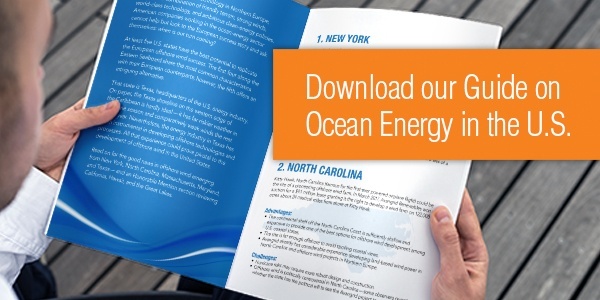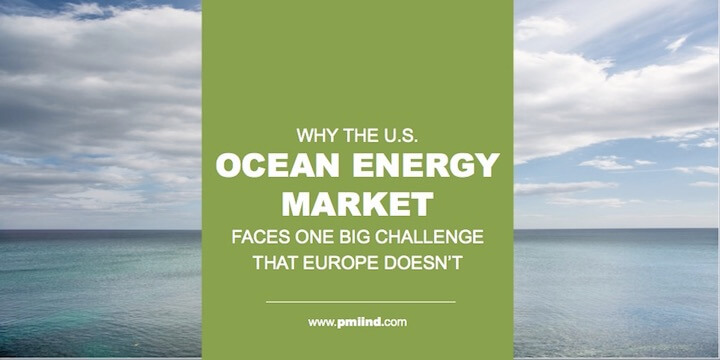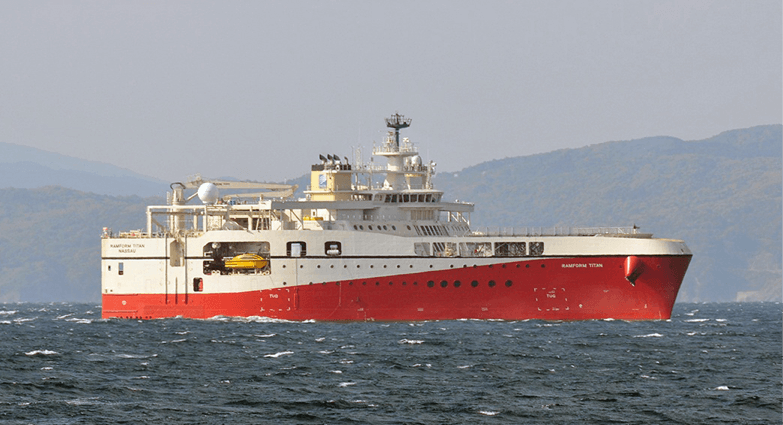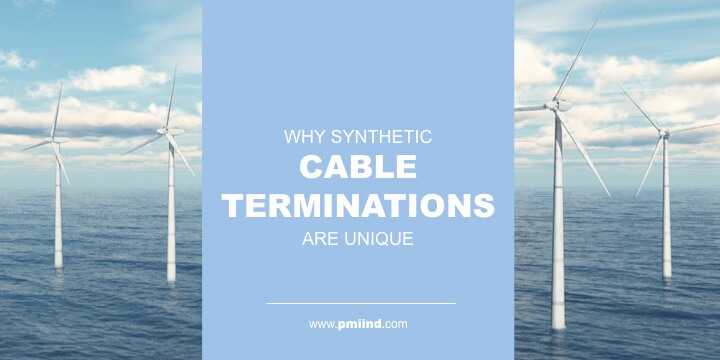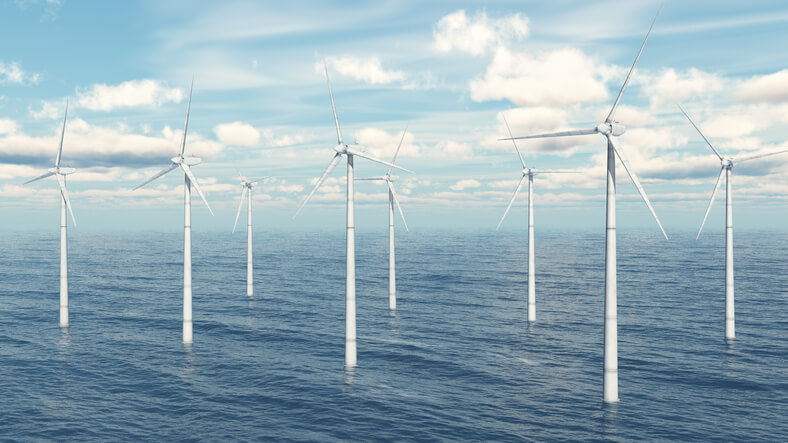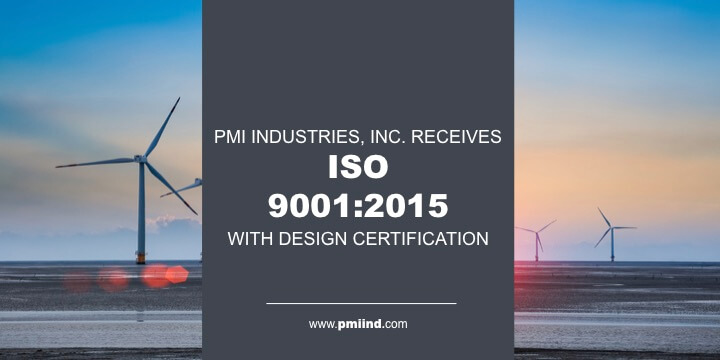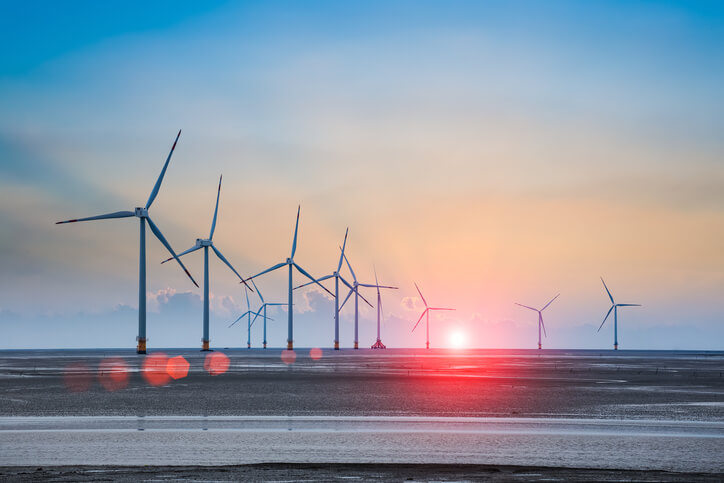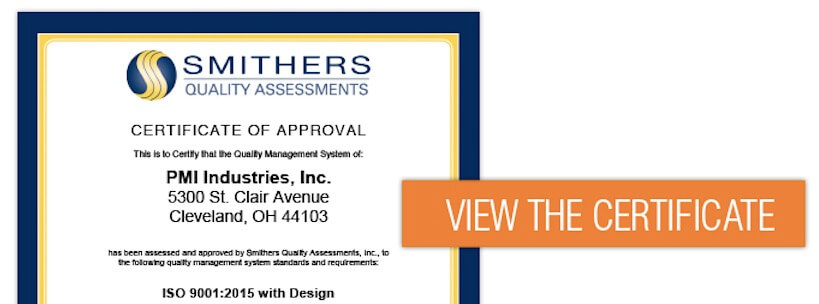Cleveland, OH— PMI Project Engineer and Marine Energy Specialist Tyler Burger shares his thoughts on the future of cable maintenance and repair in offshore wind farms with Windpower Engineering and Development in the article “The future of cable maintenance and repair in offshore wind farms.”
Converting the immense power of our oceans into reliable electricity to light our cities, fuel our travels, and make our homes habitable is one of the great engineering challenges of our time.
A beguiling array of wave-energy devices, tidal turbines, and coastal-barrage proposals are in the works to meet this challenge, but the prospect of them competing with wind and solar power is a distant one indeed. That’s because the realities of designing, building, and deploying these devices are incredibly complex.
Tidal and wave equipment falls into these categories:
- Power-conversion devices that use blades, turbines, and other hardware to capture the kinetic energy of moving seawater and flowing rivers and convert it to a stream of usable electricity.
- Cables to transmit power from the devices to the mainland and sometimes are also required to hold these devices in place.
- Cable accessories to connect cable arrays and devices to efficiently transmit the generated power and extend their capabilities.
- Moorings that anchor devices to the sea floor via cables, ropes, or chains.
All this equipment must work together, and failure of any one component can bring the whole system down.
These are the five main equipment complications confronting tidal and wave engineers:
1. Expense of early-stage development
Ocean-energy device costs remain extremely high because there are no benefits of manufacturing at scale. Each device has to be painstakingly designed, constructed, and tested in laboratories, then turned into prototypes to be tested in actual ocean waters.
The long process of trial and error requires funding to survive. Right now, a lot of funding is coming from governments because private companies don’t see much chance of getting a strong return on their investment.
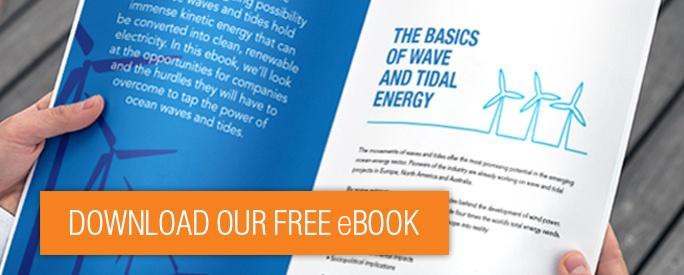
2. Abundance of unproven prototypes
There are at least a dozen or more promising devices for capturing the motion of waves and the rise and fall of tides. With wave energy, devices can move up, down, and side-to-side, generating motion that can be converted into electricity.
But because the motion of waves is affected by surface winds, weather, and local topography, wave action is highly idiosyncratic and difficult to capture reliably. Furthermore, an ocean-energy device that works great in one locale might be terrible in another, making it difficult to develop a standard design.
An example of proposed wave energy devices includes:
- Floats or buoys that move up and down with the waves’ motions. This movement is converted to kinetic energy that powers an electrical generator. (Wired magazine profiles an intriguing buoy design from a Swedish company.)
Tidal power examples:
- One project uses devices that look like wind turbines, except they’re mounted underwater.
- Another project uses a gigantic metal water wheel with blades that spin from the motion of advancing and retreating tides.
Each of these proposed ocean-energy devices is intriguing in its own right, but there’s still a sharp contrast with offshore wind, where there’s a strong consensus on the most viable technology and a track record of which devices work best.
3. Environmental disruption
Any large mechanical device placed into an active ocean ecosystem is going to be problematic. Spinning blades may injure or kill aquatic species. A coastal barrage for tidal energy might upset an entire estuarial ecosystem.
Mechanical devices also can leak lubricants and emit noises that make trouble for fish and aquatic mammals. Engineers can tweak their designs in an attempt to minimize environmental damage, but they really can’t be sure what will happen until they get their prototypes in the water, so it’s difficult to solve these problems on the drawing board before they become much more expensive.
4. Unpredictable weather
Though waves splash endlessly against the coastline, their frequency and amplitude shifts constantly because wind has so much influence on water at the surface. Rough conditions are often a good thing for these devices because it means more motion, thus more energy created. But electricity users require a regular, reliable energy stream — not one that changes every time a low-pressure system moves in. This is why battery storage is being considered in some cases.
Hurricanes, tsunamis, typhoons, and other calamities pose a realistic risk of destroying equipment in an instant, while day-to-day crashing of the seas wears equipment out over months and years. Either way, engineers have to build incredibly robust machinery to survive the whims of weather because these devices are going in high-energy locations that have previously been avoided by subsea cable and construction projects. Even wind power installations still face some of these same demanding issues, as they are not unique to tidal energy.
5. Corrosion and bio-fouling
Devices strong enough to convert waves into energy typically require the strength of metal alloys. The trouble is that saltwater is so corrosive to tough, economical alloys like steel. That requires an extra level of care at the design, construction, and installation phases to fend off the effects of corrosion. Admittedly, there are many metallic alloys that have amazing corrosion resistance, but building entire energy arrays out of these metals will be inherently costly.
And then there are the creatures that attach themselves to anything we put in the ocean. Small animals and plant life can attach to the moving parts of underwater devices, creating potential for costly breakdowns and maintenance.
New technology and development is on the horizon
The challenges of ocean energy equipment are no reason to give up and move on. This is especially true in light of news that a commercial-scale tidal-energy project in Scotland got the green light for development in June 2017.
Obviously, offshore wind will be the most productive marine-energy source for the foreseeable future, but as long as the oceans keep moving, engineers, researchers, inventors, and entrepreneurs will be scouting for ways to bring tidal and wave energy into the mainstream.
One thing’s for sure: The ocean-energy industry will need tough, long-lasting cable accessories to solve the attachment, transmission, and cable repair part of this puzzle. PMI is your premier resource for those cable accessories.
Related articles:
- Pros and Cons of Tidal Energy
- Hurdles in Establishing Practical & Reliable Wave Energy
- Six Obstacles to the Development and Commercialization of Marine Energy Devices
There’s nothing quick about developing an offshore wind farm. It takes years of site selection, political and financial wrangling, environmental reviews, and careful construction to make it all happen. But those timelines could be getting shorter thanks to developments in the European offshore wind market.
An article in IEEE Spectrum in June 2017 noted a major breakthrough: Three new German projects are expected to be built without government subsidies — a first in the history of European offshore wind. Indeed, the scope and scale of North Sea wind farms is growing so fast and costs are falling so quickly that subsidy-free projects are happening much sooner than anybody anticipated.
“We’re three to four years ahead of schedule,” Bent Christensen, who is responsible for energy-cost projections for Siemens’ wind power division, said in the IEEE Spectrum report.
Admittedly, there’s a speculative component to the prediction of subsidy-free offshore wind power: It requires turbines that generate 13 to 15 MW, which aren’t on today’s market (the biggest turbines generate about 8 MW). IEEE Spectrum says those turbines may be seven or eight years in the future.
Reviewing the key phases of the offshore wind timeline
With subsidy-free power in the picture within a decade, developers, regulators, and manufacturers will be looking for ways to shrink the offshore wind timeline in each of its four key phases. Here’s a quick review of those phases:
- Establishing offshore wind regions: This is where government regulators identify sites that hold the most promise for offshore wind production. Studies measure the areas with most reliable wind resources and least environmental impacts. In Europe, France is seen as one of the next great offshore locales thanks to its shorelines in the North Sea, Atlantic Ocean, and Mediterranean Sea.
- Offering leases and requesting bids: Next, developers get an opportunity to lease specific sections for wind farm development. Here, utilities and regulators coordinating the arrival of the power on the mainland request bids from wind farm developers. Before preparing their bids, the developers conduct wind tests, dig bore holes and survey the sea floor to find optimum areas for development.
- Developing wind farm sites: The company with the winning bid starts developing the site in more detail. It’s time to identify precisely where the individual wind turbines will be installed and figure out which vendors will supply them. Here, cumulative advances in technologies and techniques learned at existing sites pay dividends by showing developers where they can chip away at time-consuming processes. Of course, anything in the plans that present potential risks to ecosystems, fisheries, tourism, and coastal views can bog down the development phase. Another major wrinkle is rounding up financing to get the projects built.
- Fabricate and construct wind farm: Mass production and standardization help developers rein in costs at the construction phase. This also is the phase where the weather starts to loom large. Though coastal storms can throw off timelines and potentially damage turbines during construction, advances in weather prediction technologies can help developers better prepare for severe weather.
Welcome news from European offshore wind
At PMI, we’re watching all these developments closely because we manufacture premium accessories for underwater cables that transmit electricity from offshore wind farms to the mainland power grid. We expect innovations in ocean renewables to be good for our business as well as the planet.
It’s true that offshore wind remains one of the most expensive renewable power sources, but costs are falling rapidly, according to IEEE Spectrum: Just four years ago, new projects were providing power at about €160 (US $179) per megawatt-hour amid hopes to reduce those costs to €100/MWh by 2020. Christensen of Siemens says prices are hitting that goal in 2017.
Ever-larger and more efficient wind farms should drive those costs lower in the years ahead, potentially attracting more investors, inventors and developers into the marketplace. This has the potential to motivate developers to shrink wind farm timelines as well.
On average, European offshore wind turbines stand in 29 meters (95 feet) of water about 44 kilometers (27 miles) from the shore, WindEurope reports. These two stats underscore one of the key reasons why offshore wind in U.S. waters is a flyspeck compared to the installed capacity of European wind farms.
The first U.S. offshore wind farm added a scant 30 megawatts of electrical capacity when construction wrapped up in 2016. By contrast, grid-connected capacity of European offshore wind farms rose by more than 1,600 MW in 2016 alone — with 338 new wind turbines expanding total capacity to 12,600 MW, according to WindEurope.
European leaders deserve plenty of credit for achieving bold offshore-wind goals, but that’s not the only force at work in Europe’s offshore-power dominance. The waters of the North, Irish, and Baltic seas tend to be shallow near the shoreline and fall gradually to maximum depths.
This is the optimum terrain for today’s offshore-wind technologies — and it’s abundant. By contrast, the entire west coast of the U.S. plunges deeply into the Pacific Ocean just off the shoreline. The continental shelf on the Atlantic Coast and the Gulf of Mexico is much larger and shallower, but the specter of summer hurricanes casts a cloud on projects in warmer southern climes.
In essence, the most promising proposals for wind farms in U.S. waters lie in the cooler waters from the Carolinas northward to Maine. These waters boast a gently sloping continental shelf, much like the areas dotted with wind farms off the coast of Northern Europe. And while these northern waters are no strangers to fierce storms, they generally do not experience the destructive force of hurricanes.
 Turning to deep-water development
Turning to deep-water development
Europe’s massive lead over North America in offshore wind shouldn’t obscure one central fact: European countries have fulfilled only a fraction of their offshore-wind power goals. And, like an apple tree bereft of low-hanging fruit, they have already developed many of the most valuable offshore-wind sites.
As offshore wind projects move farther from the coastline in Europe, naturally the water gets deeper. Soon, the fixed foundations for wind turbines will become prohibitively difficult to manufacture and install. This challenge invites the development of floating offshore wind platforms.
Floating platforms sound promising on paper, but only a few demonstration projects have gotten off the drawing board. But that could rapidly change in the space of a few years, according to WindEurope, the trade association for European wind power.
In a report issued in June 2017, WindEurope stated that floating platforms are ready for commercial development, and that costs could soon plunge as the technology enters the mainstream.
“Floating offshore wind offers a vast potential for growth,” WindEurope said. “80% of all the offshore wind resource is located in waters 60m and deeper in European seas, where traditional bottom-fixed offshore is less attractive. At 4,000 GW, it is significantly more than the resource potential of the U.S. and Japan combined.”
The report listed seven floating-platform projects in the works in Scotland, Ireland, Portugal, France, and the UK with nearly 350 MW of capacity that are expected to be commissioned in the next four years.
Taking a cue from offshore oil development
PMI has long provided premium cable accessories to oil-development companies, so we have a healthy respect for the difficulties in extracting energy from the deep ocean. And we’ve admired the ability of our industry partners to overcome these challenges.
But accidents happen despite the best efforts of the industry. Though floating offshore wind farms pose their share of environmental threats, there’s little chance of them being blamed for massive oil spills.
That’s one of the best reasons to be optimistic about the potential of offshore wind in the U.S. And as European developers build out floating platforms and drive down costs, American developers would be well advised to take advantage of the inevitable innovations that emerge.
The third of four Ramform Titan-class vessels, the Ramform Tethys, was celebrated in a naming ceremony at the Mitsubishi Heavy Industries Shipbuilding Co. yard in Nagasaki, Japan today.
PGS’ two first Ramform Titan-class vessels, the Ramform Titan and the Ramform Atlas were delivered in 2013 and 2014 and have delivered beyond expectations on all aspects, especially within safety, efficiency and productivity.
The Ramform Tethys, and the Ramform Hyperion, will be even better due to small modifications of equipment handling on the back deck and an increase in engine power to 26 400 kW from 23 040 kW on the first two Ramform Titan-class vessels.
“With the increased power output and the back deck modifications we are enhancing the Ramform Titan-class acquisition platform further. Productivity, safety, stability and redundancy are the key benefits of these vessels. Their ability to tow many streamers gives high data quality with dense cross-line sampling and cost efficient acquisition with wide tows,” says Per Arild Reksnes, EVP Operations.
The Ramform Tethys is the most powerful and efficient marine seismic acquisition vessel in the world, and along with the Ramform Titan and Ramform Atlas, the widest ships ever at the waterline.
The design dovetails advanced maritime technology to the imaging capabilities of the GeoStreamer® seismic acquisition technology. Her 70 meter broad stern is fully exploited with 24 streamer reels: 16 reels aligned abreast and 8 reels further forward, with capacity for 12 kilometer streamers on each reel. With such capabilities the Ramform Tethys has tremendous flexibility and redundancy for high capacity configurations. Increased work space and advanced equipment handling mean safer and even more robust operations. The Ramform concept design is made by Roar Ramde.
She carries over 6 000 tons of fuel and equipment. She will typically tow a network of several hundred thousand recording sensors over an area greater than 12 square kilometers, equivalent to nearly 1 200 soccer pitches, or 3.5 times Central Park.
For PGS and its clients, more rapid deployment and retrieval of equipment, as well as greater operational capacity will translate into faster completion of surveys and increased uptime in marginal weather. The period between major yard stays is also extended by approximately 50%.
The Ramform Tethys sets the new standard for seismic operations for the next 25 years.
Jon Erik Reinhardsen, President and CEO of PGS states in a comment: “The Ramform Tethys further strengthens our fleet productivity and together with the other Ramform Titan-class vessels will enhance our competitive edge. In the current challenging market environment we also experience more demand for our best capacity and Ramform Tethys will add to PGS ultra-high-end value proposition.”
NOTE: Pictures and more facts on the Ramform Tethys are available on www.pgs.com
For details, contact:
Bård Stenberg, VP IR & Corporate Communications
Mobile: +47 992 45 235
Synthetic cable is stronger than steel on a strength-to-weight basis, which makes it an attractive option in marine environments. The key challenge of synthetic cable is what you do about the attachment points, or terminations.
Terminations can cut the tensile strength of synthetic cable by more than 50 percent, potentially defeating the purpose of going with synthetic to begin with. However, a well-designed and properly installed termination can preserve more than 75 percent of the cable’s strength.
The termination must be installed by the manufacturer of the termination. It can’t be installed like a traditional steel termination can. That means if you’re ordering a volume of synthetic fiber cable, you need to ship it to your cable accessory supplier and have them cut your cable to length and attach the terminations.
Once the termination is in place, it’s there permanently. It cannot be removed. Hence it pays to be careful about your choice of synthetic cable termination provider.
Getting it Right with Synthetic Cable Terminations
Synthetic cables have a vast range of uses in subsea environments. They can do high-tech jobs like protecting fiber optic cables that transmit data around the world. Or they can do more mundane tasks like holding floating platforms in place.
Each of these jobs require terminations and other accessories that are engineered specifically to get the most performance out of the cable and preserve its strength at the attachment point.
At PMI, we’ve worked with clients in the subsea cable sector for decades, so we know exactly how to apply the right termination for each application. We have the specialized equipment required to perform synthetic terminations, and we have people trained to make sure the attachment is done properly.
And, of course, we supply some of the world’s best subsea cable terminations for all these varied applications.
Synthetic cables are less prone to corrosion and much more flexible and easy to use in chaotic marine environments. Many of them even float. But their unique chemical composition requires extra care at the termination point. Ignoring this risk could easily undo your entire investment in synthetic cables.
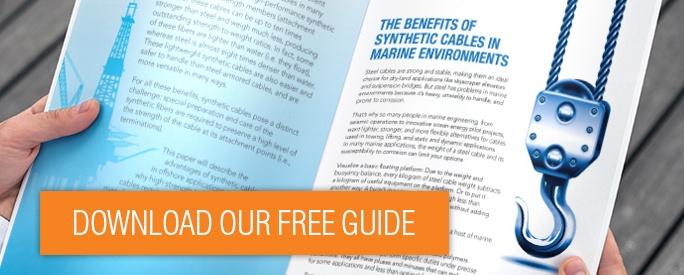
PMI Industries, Inc. is proud to announce that as of January 16, 2017, it has been ISO 9001: 2015 with Design certified with regard to the design, manufacture and distribution of offshore, subsea cable hardware assemblies and testing services.
PMI is delighted to serve our customers even better through the well-defined and documented processes this certification requires. While PMI has always been committed to quality in its products and services, this certification ensures a more productive environment through faster identification and resolution of quality issues, among many other benefits.
“This certification is a reflection of our longstanding commitment to quality, continuous improvement and our customers,” said Bob Schauer, President of PMI Industries, Inc. “We’re very proud of the dedication put forth by the PMI team.”
PMI partnered with Smithers Quality Assessments, an accredited quality and environmental management systems certification body, to achieve certification.
For more information about PMI Industries’ products and services for offshore oil and gas, please visit pmiind.com, and for more information about PMI Industries’ products and services in offshore renewable energy, please visit powerofpmi.com.
Cleveland, OH—PMI Industries, Inc. is proud to announce that as of January 16, 2017, it has been ISO 9001: 2015 with Design certified with regard to the design, manufacture and distribution of offshore, subsea cable hardware assemblies and testing services.
PMI is delighted to serve our customers even better through the well-defined and documented processes this certification requires. While PMI has always been committed to quality in its products and services, this certification ensures a more productive environment through faster identification and resolution of quality issues, among many other benefits.
“This certification is a reflection of our longstanding commitment to quality, continuous improvement and our customers,” said Bob Schauer, President of PMI Industries, Inc. “We’re very proud of the dedication put forth by the PMI team.”
PMI partnered with Smithers Quality Assessments, an accredited quality and environmental management systems certification body, to achieve certification.
For more information about PMI Industries’ products and services for offshore oil and gas, please visit pmiind.com, and for more information about PMI Industries’ products and services in offshore renewable energy, please visit powerofpmi.com.

